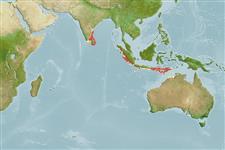>
Eupercaria/misc (Various families in series Eupercaria) >
Labridae (Wrasses) > Cheilininae
Etymology: Cirrhilabrus: Latin, cirrus = curl fringe + Greek, labros = furious (Ref. 45335); adornatus: Named in reference to the bright red markings on the body and dorsal fin (Ref. 31269).
More on authors: Randall & Kunzmann.
Environment: milieu / climate zone / depth range / distribution range
Ecología
marino asociado a arrecife; rango de profundidad 10 - 30 m (Ref. 31269). Tropical
Eastern Indian Ocean: known only from Indonesia (Sumatra and the Mentawai Islands).
Tamaño / Peso / Age
Maturity: Lm ? range ? - ? cm
Max length : 6.3 cm SL macho / no sexado; (Ref. 31269)
Short description
Claves de identificación | Morfología | Morfometría
Espinas dorsales (total) : 11; Radios blandos dorsales (total) : 9; Espinas anales: 3; Radios blandos anales: 9; Vértebra: 25. Scales above lateral line to origin of dorsal fin 1.5. Caudal fin of females slightly rounded or truncate, double emarginate or emarginate in males. Males whitish to pale pink with two large triangular bright red blotches dorsoanteriorly on body and a broad red border on dorsal fin except posteriorly (some with a longitudinal row of small black spots near middle of fin); females red, shading to white ventrally on head and abdomen, with a black spot three-fourths orbit diameter posteriorly on side of caudal peduncle above lateral line (Ref. 31269).
Found over rubble on outer reef slopes up to at least 30 m depth (Ref. 31269). Closely related to C. flavidorsalis and females look almost identical (Ref. 48636).
Life cycle and mating behavior
Maturities | Reproducción | Spawnings | Egg(s) | Fecundities | Larva
Distinct pairing during breeding (Ref. 205).
Randall, J.E. and A. Kunzmann, 1998. Cirrhilabrus adornatus, a new species of labrid fish from Sumatra. Rev. Fr. Aquariol. 25(1-2):41-44. (Ref. 31269)
IUCN Red List Status (Ref. 130435)
Threat to humans
Harmless
Human uses
Herramientas
Special reports
Download XML
Fuentes de Internet
Estimates based on models
Preferred temperature (Ref.
123201): 20.8 - 29.2, mean 28.4 °C (based on 10 cells).
Phylogenetic diversity index (Ref.
82804): PD
50 = 0.5000 [Uniqueness, from 0.5 = low to 2.0 = high].
Bayesian length-weight: a=0.01585 (0.00707 - 0.03555), b=2.95 (2.76 - 3.14), in cm total length, based on LWR estimates for this (Sub)family-body shape (Ref.
93245).
Nivel trófico (Ref.
69278): 3.3 ±0.4 se; based on size and trophs of closest relatives
Resiliencia (Ref.
120179): Alto, población duplicada en un tiempo mínimo inferior a 15 meses (Preliminary K or Fecundity.).
Fishing Vulnerability (Ref.
59153): Low vulnerability (10 of 100).
